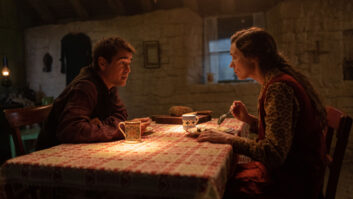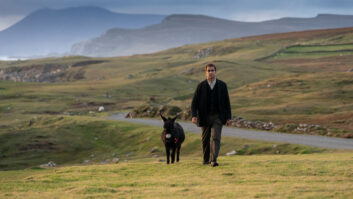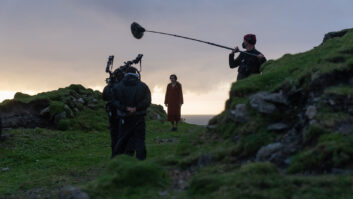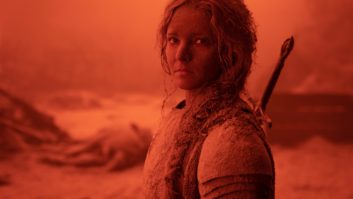Nominated for eight Academy Awards including Best Picture, The Banshees of Inisherin is the third film that director of photography Ben Davis has made with director Martin McDonagh, after Seven Psychopaths and Three Billboards Outside Ebbing, Missouri. “Martin loves cinema,” says Davis. “He loves the beautiful image, and hand in hand, we’re trying to find that.”
 The Banshees of Inisherin is a human-scale tragicomedy with hints of allegory, and an acting tour de force starring Kerry Condon, Brenden Gleeson, and Colin Farrell. McDonagh wanted a film that celebrated the beauty and majesty of the Irish landscape. Davis found his way to the right look by shooting digitally, doing a film-out to emulsion, and then scanning the frames back to digital. The final images draw audiences into a remote island community in 1923 Ireland, lit only by oil lamp, candlelight and dim sunlight.
The Banshees of Inisherin is a human-scale tragicomedy with hints of allegory, and an acting tour de force starring Kerry Condon, Brenden Gleeson, and Colin Farrell. McDonagh wanted a film that celebrated the beauty and majesty of the Irish landscape. Davis found his way to the right look by shooting digitally, doing a film-out to emulsion, and then scanning the frames back to digital. The final images draw audiences into a remote island community in 1923 Ireland, lit only by oil lamp, candlelight and dim sunlight.
Exteriors are often shot into direct sunlight. Interiors like the local pub, a key setting, are shadowy. “We talked in great detail about the dark interior walls, which had a sort of sheen,” says Davis. “That way, the characters are lifted out in pockets of warm oil lamplight. I wanted to seamlessly transition between landscapes and close-ups, and I wanted the closeups to be shaped. I did a lot of work lighting the close-ups so that the faces had contour. I wanted to see all the creases and the grime in the faces. I wanted to really feel landscapes in the close-ups, which have a wonderful sharpness.”
The taking cameras were ARRI ALEXA LFs, using CODEX recording technology to capture in the ARRIRAW format, bringing rich, high resolution image files into post. The lenses were ARRI Signature Primes. Davis says he didn’t change exposure or his other on-set methods due to the digital-film-digital post path.
“We have a LUT that I’ve worked with for a long time,” he says. “It isn’t aggressive in any way, and it’s not particularly high contrast. It’s just there to give me an idea of where I’m going to end up. If I want something to look a certain way, I’ll photograph it that way, just as I would with film negative. I’m not really interested in multiple LUTs. When I used to shoot film, I had a favourite negative, and it’s the same way with a LUT for me. You understand the limitations, where you can push it and where you can’t. My philosophy is to keep things straightforward on the set.”
Continuing the comparison with film emulsion, Davis says, “The best results on film were always achieved by pushing the shadow areas or highlights to the very limit. The blacks were as black as you could get them while managing to maintain some detail. With chemical finishing and film projection, by the second or third generation, you could get in trouble, especially with an old projector bulb.
“Obviously, that’s not as difficult to achieve with digital, because the image is there in front of you, and as a result, you can set up correctly and push it to the very edge,” he says. “Greig Fraser’s work on The Batman is a wonderful example. He’s pushing the boundaries. You could never shoot a film like that back in the film days.
 “On Banshees, the challenge on interiors was that the shadows are right down there in the bottom edge of the camera’s exposure,” Davis says. “I often pushed the shadow side of an actor’s face or the background down as low as possible without losing detail, because that’s what creates something that looks interesting. I didn’t get any negative comments from the studio or the producers; they could see that detail. And if you’re going to work that way, you need them to back you up.”
“On Banshees, the challenge on interiors was that the shadows are right down there in the bottom edge of the camera’s exposure,” Davis says. “I often pushed the shadow side of an actor’s face or the background down as low as possible without losing detail, because that’s what creates something that looks interesting. I didn’t get any negative comments from the studio or the producers; they could see that detail. And if you’re going to work that way, you need them to back you up.”
Davis adds that the advent of larger, higher resolution television screens has helped. “There’s much more of an appetite for things that are darker and living in the shadows, and if it suits the material, I think the audience are very up for that,” he says.
The production used PIX, the industry standard production management platform, to communicate during the shoot. “That’s how Martin and our producers were watching the material,” says Davis. “It was difficult on such a remote location with no lab facility close by, and we were literally quarantined on an island. We didn’t have a great deal of Wi-Fi bandwidth, but there were a couple places where we could boost it up. PIX worked really well for us in that situation. The image quality has come a long way. They’ve dealt with the compression issues quite well, which was important given how we were working at the bottom end of what the camera can do.”
Goldcrest in London handled the digital-film-digital workflow under Davis’s supervision. CineLab was also a key player in the process, including dailies. Davis sees the technique as the wave of the future. Theoretically, he says, different film stocks could be used in the post process to create the right look for certain scenes. In the case of Banshees, he chose fine grain negative because the effect was filmic yet not overwhelming.
 “It’s at the forefront of cinematography at the moment,” says Davis. “We did our first basic pass on the DI and then shipped the digital neg off for the creation of a film neg using fine grain stock. That was scanned back in, and the work we had already done in the DI was applied. In some cases, you build in a little offset, but it comes in pretty close. And then we did some final tweaks based on that. When we were doing the final DI, we could choose whether to use the original digital shot. For some of the big wide shot with small characters far away, if we felt we lost a little bit of the character, we could use the digital shot without the film process, for additional clarity.”
“It’s at the forefront of cinematography at the moment,” says Davis. “We did our first basic pass on the DI and then shipped the digital neg off for the creation of a film neg using fine grain stock. That was scanned back in, and the work we had already done in the DI was applied. In some cases, you build in a little offset, but it comes in pretty close. And then we did some final tweaks based on that. When we were doing the final DI, we could choose whether to use the original digital shot. For some of the big wide shot with small characters far away, if we felt we lost a little bit of the character, we could use the digital shot without the film process, for additional clarity.”
One example, perhaps Davis’s favourite shot in the film, is the scene in which Siobhan (Condon), in the distance and framed by the sea and the foreground landscape, strides purposefully across the beach on her way to her home to confront Pádraic (Farrell). Despite her small size in the frame, something essential about her character is communicated by the tiny, billowing figure.
The Banshees of Inisherin premiered at the Venice Film Festival in September 2022, where it met with a 15-minute standing ovation. It also took honours at the British Academy Film Awards for Outstanding British Film.
Davis is currently in post on Wicked Little Letters, a feature film that takes place in roughly the same 1920s time period. He plans to go with the digital-film-digital workflow once again, but this time, he is considering a slightly more aggressive approach, using a 250 Daylight film stock for the negative step.







